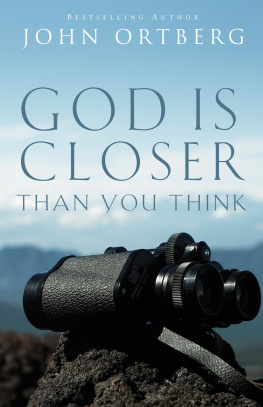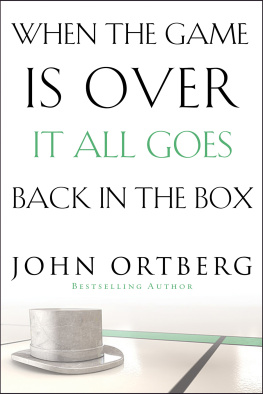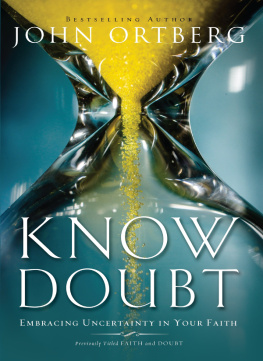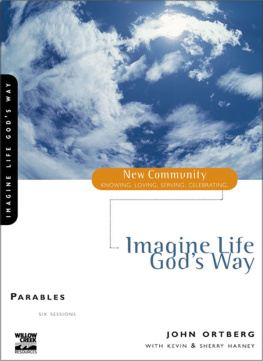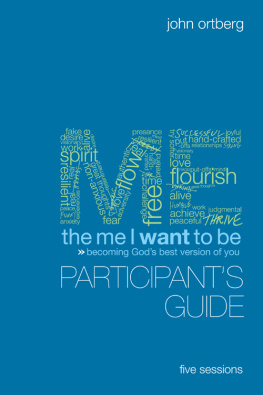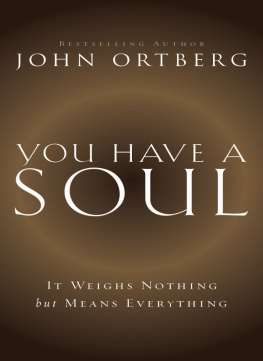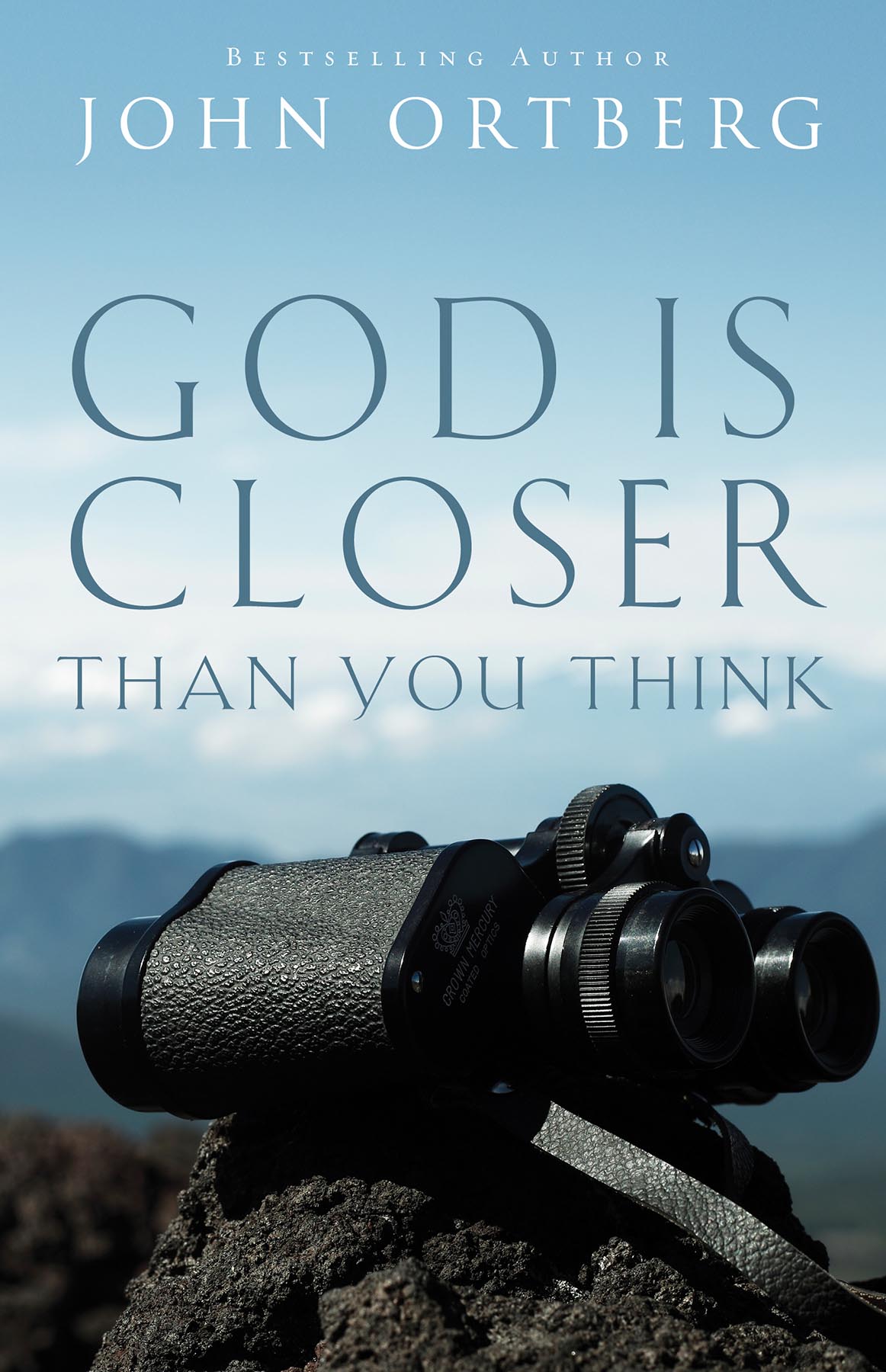Resources by John Ortberg
Everybodys Normal Till You Get to Know Them
(book, ebook, audio)
God Is Closer Than You Think
(book, ebook, audio, curriculum with Stephen and Amanda Sorenson)
If You Want to Walk on Water,
Youve Got to Get Out of the Boat
(book, ebook, audio, curriculum with Stephen and Amanda Sorenson)
Know Doubt
(book, ebook, previously titled Faith and Doubt)
The Life Youve Always Wanted
(book, ebook, audio, curriculum with Stephen and Amanda Sorenson)
Love Beyond Reason
The Me I Want to Be
(book, ebook, audio, curriculum with Scott Rubin)
Soul Keeping
(book, ebook, curriculum with Christine M. Anderson)
When the Game Is Over, It All Goes Back in the Box
(book, ebook, audio, curriculum with Stephen and Amanda Sorenson)
Who Is This Man?
(book, ebook, audio, curriculum with Christine M. Anderson)
ZONDERVAN
God Is Closer Than You Think
Copyright 2005 by John Ortberg
This title is also available as a Zondervan audio product.
Visit www.zondervan.com/audiopages for more information.
Requests for information should be addressed to:
Zondervan, 3900 Sparks Dr. SE, Grand Rapids, Michigan 49546
This edition: ISBN 978-0-310-34047-8 (softcover)
Epub Edition March 2020 9780310565819
Library of Congress Cataloging-in-Publication Data
Ortberg, John.
God is closer than you think / John Ortberg. 1st ed.
p. cm.
Includes bibliographical references and index.
ISBN 978-0-310-25349-5 (hardcover)
1. Presence of God. 2. Christian life Presbyterian authors. I. Title.
BV4509.5.O78 2005
248.4 dc22
2004024716
Some names and details have been changed in order to protect the privacy of people involved in true stories told in this book.
The Scripture versions used in this book are listed on , which hereby becomes a part of this copyright page. Italics in quotations of Scripture have been added by the author for emphasis.
Any Internet addresses (websites, blogs, etc.) and telephone numbers in this book are offered as a resource. They are not intended in any way to be or imply an endorsement by Zondervan, nor does Zondervan vouch for the content of these sites and numbers for the life of this book.
All rights reserved. No part of this publication may be reproduced, stored in a retrieval system, or transmitted in any form or by any means electronic, mechanical, photocopy, recording, or any other except for brief quotations in printed reviews, without the prior permission of the publisher.
Interior design by Michelle Espinoza
Printed in the United States of America
14 15 16 17 18 19 /DCI/ 20 19 18 17 16 15 14 13 12 11 10 9 8 7 6 5 4 3 2 1
To Laura, Mallory, and Johnny;
for Winston and Milo and Spotty and Jo-Jo;
for the furnace man and Ralph the Tree and Fred the Bread;
for the barn story and Bugs Meany and Norman Bates
and Portillos and all the times I saved the presidents life;
for the gift that binds my anniversary and
Thanksgiving and Groundhog Day;
for doughnut runs and dollar days
and thin places in the hedge...
And to Nancy
CONTENTS
Guide
I n the course of writing this book I moved from the Midwest to California and joined the staff of Menlo Park Presbyterian Church. I am very grateful to the people of MPPC for giving me time to write and offering such a loving community to be a part of. John Mumford provided a place to write that gave me a look at what novelist Wallace Stegner called the last sunset on the continent; any lack of inspiration is due to me and not the view. Trudi Barnes partnered with extraordinary energy to make this project and so much other ministry possible.
Peets Coffee kept what neurons I have in firing mode.
This marks the fifth book I have written with Zondervan, and I am grateful for the sense of partnership that has deepened with each one. Jack Kuhatschek offered countless hours of conversation and thought. John Topliff and Greg Stielstra combine wisdom and soulishness with savvy and energy. Jim Ruark polished the prose. Scott Bolinder and Stan Gundry and the rest of the team have made it a kind of writing home for which I am deeply grateful.
Both Liz Heaney and Evelyn Bence offered many helpful suggestions.
As always, the thought and work of Dallas Willard was never far away when I was writing.
But my favorite collaborator on this project was Mallory Ortberg. She edited the entire manuscript in an early draft, made too many contributions to count, and wrote material that took my breath away. Someday, if Im lucky, she may let me edit some of her stuff.
For over the margins of life comes a whisper, a faint call, a premonition of richer living....
Thomas Kelly
D uring the first year of our marriage, Nancy and I spent two months traveling around Europe. We lived on a budget of $13.50 per day for food, lodging, and entertainment. We breakfasted every morning on bread and cheese. We lodged in accommodations compared with which the Bates Motel in the movie Psycho would be an upgrade. Entertainment on that budget consisted of buying Time magazine once a week and ripping it in half so we could both read it at the same time.
We splurged in Italy, where we blew one whole days allowance on a single meal and spent money we could not afford to look at the treasures of Western art. The highlight of the day came after standing in line for hours at the Vatican to view Michelangelo Buonarrotis brilliant painting of God and Adam on the ceiling of the Sistine Chapel. His masterpiece is one of two works of art that serve as touchstones for this book. (Im saving the other one for the next chapter.) If you look carefully at the painting, you notice that the figure of God is extended toward the man with great vigor. He twists his body to move it as close to the man as possible. His head is turned toward the man, and his gaze is fixed on him. Gods arm is stretched out, his index finger extended straight forward; every muscle is taut.
Before Michelangelo, art scholars say, the standard paintings of creation showed God standing on the ground, in effect helping Adam to his feet. Not here. This God is rushing toward Adam on a cloud, one of the chariots of heaven, propelled by the angels. (In our day they dont look quite aerobicized enough to move really fast, but in Michelangelos day the angels suggested power and swiftness.) It is as if even in the midst of the splendor of all creation, Gods entire being is wrapped up in his impatient desire to close the gap between himself and this man. He cant wait. His hand comes within a hairbreadth of the mans hand.
The painting is traditionally called The Creation of Adam, but some scholars say it should be called The Endowment of Adam. Adam has already been given physical life his eyes are open, and he is conscious. What is happening is that he is being offered life with God. All of mans potential, physical and spiritual, is contained in this one timeless moment, writes one art critic.
Apparently one of the messages that Michelangelo wanted to convey is Gods implacable determination to reach out to and be with the person he has created. God is as close as he can be. But having come that close, he allows just a little space, so that Adam can choose. He waits for Adam to make his move.
Adam is more difficult to interpret. His arm is partially extended toward God, but his body reclines in a lazy pose, leaning backward as if he has no interest at all in making a connection. Maybe he assumes that God, having come this far, will close the gap. Maybe he is indifferent to the possibility of touching his creator. Maybe he lacks the strength. All he would have to do is lift a finger.

